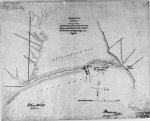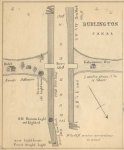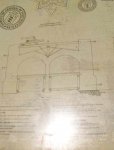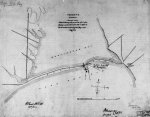Hope this is a big drum-roll!
:yay:We have been working our way around the "Old Fort" for some time and surprisingly there is lots of information coming in little dribbles. Remember the Lake you face daily is just a whole bunch of dribbles. I copied all the posts on topic and re read them on the way to the doctor today. Hubby drove! I came home and have spent 6 hours using every search skill I have and garnered one little gem. I now have another timeframe, validation it was known as a fort, manned as a fort, and some names of once living souls who were connected to it. I've taken great care to document the source to keep all happy.:hail:
SOURCE
THE VOLUNTEER REVIEW AND MILITARY AND NAVAL GAZETTE
Ottawa: G. Moss (1867)
CHIM no. 8_04948_15
Vol 1, no. 15 (Apr 15, 1867)
page 8
Apr. 13
FROM WELLINGTON SQUARE
To look at the name of that place, consider the person whose name it claims, and also the names of a few of the residences, such as Bar(?)arco Terrace, Talavera Lodge, Salamanca Villa , Waterloo Road, etc. you would imagine it was inhabited by military celebraties, and it is not for want of energy on the part of the people themselves that they are not such. For the present, however, not even a company has it’s head-quarters here. But many of the inhabitants belong to the force elsewhere. Through the energy of Mr. W. Kerns (now Ensign of one of the neighbouring companies), there was a fine company raised. They were first organized as Infantry and accepted as such. Lieut. Col. Villiers afterwards received orders to garrison (or rather to prepare to do so) the fort at the beach, which commands the entrance to Burlington Bay, and as Wellington Square was considered the best place to have such an artillery, but has not been gazetted yet. The men are very patient, but are very anxious to know their destiny, and to get to work in some branch of the defensive force. :tbu:
Note
Until today I have been under the misconception that Head Of The Lake and Burlington Heights were one and the same. Today I read that Head of the Lake is the Beach and Burlington Heights (I one I was already sure of) is the area of Dundurn Castle and the Cemetery where the earthworks from 1812 are. If this is correct I have seen other notations of something going on at Burlington Heights (War 1812 era) and barrack and guns at the Head Of The Lake in the same sentence. I will be hunting them up again.
With the information we have we can start to put together some possibilities. Please note the following is one scenerio of the fort and not to be taken as historical fact. :nonono:
There is a strong possibility that the fort wasn't in existence when Lady Simcoe was on the beach. With all the confirmed or noncomfired stories of the Burlington Races they never mention support from or the Americans backing away from the presence of a fort at the canal. Now it would be prudent after that time to look at defending a very valuable port and safe haven after the American invasion. Now comes the part of finding out who and why it was built. Someone, some militia or British regulars (not likely) would have manned it. Someone looked after a light they built there. It could have become unnecessary a few years later. Then along comes the Rebellion of 1837. Again there is a need to protect the harbour. Militia goes home and the fort is used for whoever knows what. Then the Fenians arrive 1866. The above puts together a unit in /67. Probably not a coincidence at all. I'm sure that all the time before this some unit at periodic times used that fort or manned that fort. But this article being 1867 is very significant. It was obviously kept well enough that it was usable. The new canal was going. The limestone lighthouse was lite and I think George Thompson was there. Surprising he doesn't mention it. At least I didn't see mention of it but I will now go back and try again for the early years. Chisholm was running his business but I can't find mention of it connected with his dealings. This fort didn't die off in the early years so why is it so ignored? Still lots of work to do but one more piece of the puzzle is in place.
NOTE SCOTTO
As it was manned in 1867 there is a good possiblity that it was there for the loco picture and it might be the older building however it is still mentioned and mapped as being north of the old canal which wasn't that close to the new one. For that picture the new canal would be almost on top of the original.
We may have just learned the name of the Old Fort
THE FORT
or
THE FORT at the BEACH
or
THE FORT at the BURLINGTON CANAL
as in the article it wasn't referred to with military reverence as Fort George or Fort Erie or Fort York. Just the fort.
Hope someone else is smiling cause I am,
Drogo
:yay:We have been working our way around the "Old Fort" for some time and surprisingly there is lots of information coming in little dribbles. Remember the Lake you face daily is just a whole bunch of dribbles. I copied all the posts on topic and re read them on the way to the doctor today. Hubby drove! I came home and have spent 6 hours using every search skill I have and garnered one little gem. I now have another timeframe, validation it was known as a fort, manned as a fort, and some names of once living souls who were connected to it. I've taken great care to document the source to keep all happy.:hail:
SOURCE
THE VOLUNTEER REVIEW AND MILITARY AND NAVAL GAZETTE
Ottawa: G. Moss (1867)
CHIM no. 8_04948_15
Vol 1, no. 15 (Apr 15, 1867)
page 8
Apr. 13
FROM WELLINGTON SQUARE
To look at the name of that place, consider the person whose name it claims, and also the names of a few of the residences, such as Bar(?)arco Terrace, Talavera Lodge, Salamanca Villa , Waterloo Road, etc. you would imagine it was inhabited by military celebraties, and it is not for want of energy on the part of the people themselves that they are not such. For the present, however, not even a company has it’s head-quarters here. But many of the inhabitants belong to the force elsewhere. Through the energy of Mr. W. Kerns (now Ensign of one of the neighbouring companies), there was a fine company raised. They were first organized as Infantry and accepted as such. Lieut. Col. Villiers afterwards received orders to garrison (or rather to prepare to do so) the fort at the beach, which commands the entrance to Burlington Bay, and as Wellington Square was considered the best place to have such an artillery, but has not been gazetted yet. The men are very patient, but are very anxious to know their destiny, and to get to work in some branch of the defensive force. :tbu:
Note
Until today I have been under the misconception that Head Of The Lake and Burlington Heights were one and the same. Today I read that Head of the Lake is the Beach and Burlington Heights (I one I was already sure of) is the area of Dundurn Castle and the Cemetery where the earthworks from 1812 are. If this is correct I have seen other notations of something going on at Burlington Heights (War 1812 era) and barrack and guns at the Head Of The Lake in the same sentence. I will be hunting them up again.
With the information we have we can start to put together some possibilities. Please note the following is one scenerio of the fort and not to be taken as historical fact. :nonono:
There is a strong possibility that the fort wasn't in existence when Lady Simcoe was on the beach. With all the confirmed or noncomfired stories of the Burlington Races they never mention support from or the Americans backing away from the presence of a fort at the canal. Now it would be prudent after that time to look at defending a very valuable port and safe haven after the American invasion. Now comes the part of finding out who and why it was built. Someone, some militia or British regulars (not likely) would have manned it. Someone looked after a light they built there. It could have become unnecessary a few years later. Then along comes the Rebellion of 1837. Again there is a need to protect the harbour. Militia goes home and the fort is used for whoever knows what. Then the Fenians arrive 1866. The above puts together a unit in /67. Probably not a coincidence at all. I'm sure that all the time before this some unit at periodic times used that fort or manned that fort. But this article being 1867 is very significant. It was obviously kept well enough that it was usable. The new canal was going. The limestone lighthouse was lite and I think George Thompson was there. Surprising he doesn't mention it. At least I didn't see mention of it but I will now go back and try again for the early years. Chisholm was running his business but I can't find mention of it connected with his dealings. This fort didn't die off in the early years so why is it so ignored? Still lots of work to do but one more piece of the puzzle is in place.
NOTE SCOTTO
As it was manned in 1867 there is a good possiblity that it was there for the loco picture and it might be the older building however it is still mentioned and mapped as being north of the old canal which wasn't that close to the new one. For that picture the new canal would be almost on top of the original.
We may have just learned the name of the Old Fort
THE FORT
or
THE FORT at the BEACH
or
THE FORT at the BURLINGTON CANAL
as in the article it wasn't referred to with military reverence as Fort George or Fort Erie or Fort York. Just the fort.
Hope someone else is smiling cause I am,
Drogo



